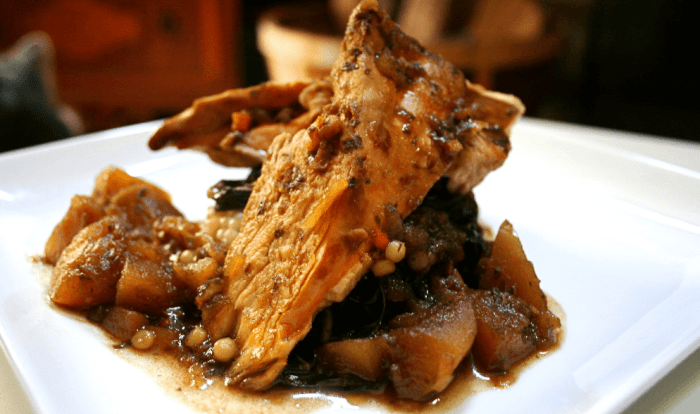
Introducing the chicken of the woods recipe, a culinary adventure that unveils the wonders of this unique mushroom. From its nutritional value to versatile cooking methods, this guide will tantalize your taste buds and inspire your kitchen creations.
Chicken of the woods, known for its vibrant colors and distinct shape, has gained popularity among foragers and chefs alike. With its meaty texture and earthy flavor, it’s a culinary gem waiting to be explored.
Introduction to Chicken of the Woods
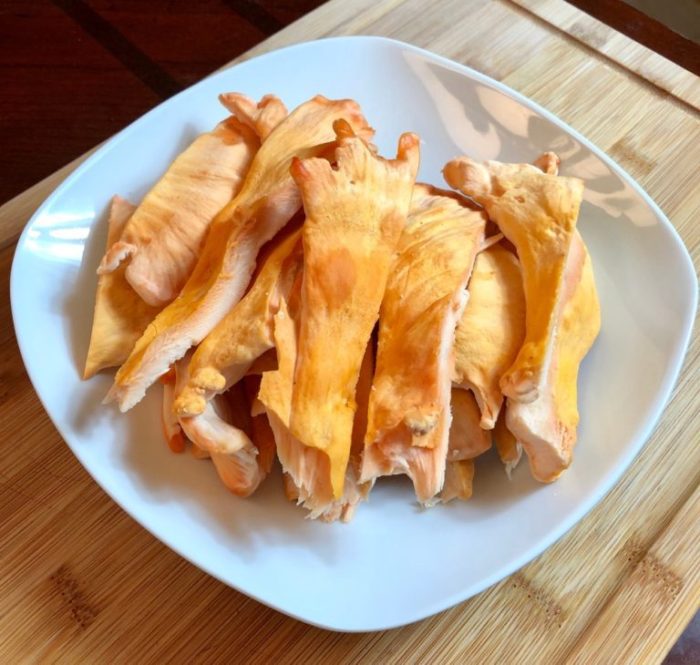
Chicken of the Woods ( Laetiporus sulphureus) is a vibrant and delectable wild mushroom that stands out in the fungal kingdom. It’s characterized by its large, shelf-like appearance and striking orange to yellow coloration, resembling the look of chicken flesh.
Chicken of the Woods is widely distributed across the globe and found in both deciduous and coniferous forests. Its abundance and distinctive appearance make it a popular choice among foragers who appreciate its culinary versatility and nutritional value.
Availability and Popularity
Chicken of the Woods is typically found during the spring and fall months, thriving on dead or decaying trees. Its availability and accessibility make it a sought-after delicacy among mushroom enthusiasts. The mushroom’s unique flavor and texture, reminiscent of chicken, have garnered it a loyal following among gourmands and nature lovers alike.
Nutritional Value and Culinary Uses
Chicken of the Woods boasts an impressive nutritional profile, offering an abundance of vitamins, minerals, and antioxidants. It’s a rich source of fiber, vitamin C, potassium, and iron. Additionally, it contains significant amounts of beta-glucans, which are polysaccharides known for their immune-boosting properties.
Culinary Versatility
Chicken of the Woods’ versatility in the kitchen is remarkable. Its meaty texture allows for various cooking methods, making it a favorite among culinary enthusiasts. It can be sautéed, grilled, roasted, or even fried. When cooked, it develops a savory, umami-rich flavor with a hint of chicken-like taste, earning it the nickname “chicken of the woods.”
Flavor Profile and Popular Uses
The flavor profile of Chicken of the Woods is complex and distinctive. It possesses a combination of earthy, nutty, and slightly sweet notes. This unique flavor makes it a versatile ingredient that pairs well with a wide range of cuisines and dishes.
It’s often used in soups, stews, stir-fries, and pasta dishes. Additionally, its meaty texture makes it an excellent substitute for chicken or other meats in vegan and vegetarian recipes.
If you’re looking for a unique and flavorful culinary experience, look no further than the chicken of the woods recipe . This vibrant orange mushroom boasts a meaty texture and earthy flavor that will satisfy even the most discerning palate.
Whether you’re a seasoned chef or a novice cook, the chicken of the woods recipe is easy to follow and yields delicious results.
Identification and Harvesting Techniques: Chicken Of The Woods Recipe
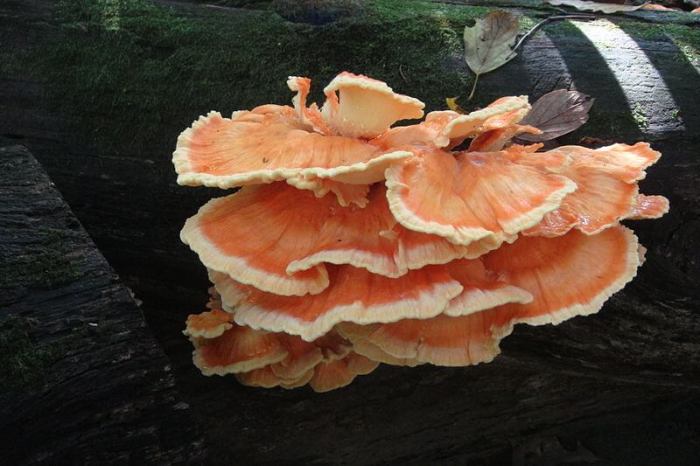
Chicken of the Woods, scientifically known as Laetiporus sulphureus, is a distinctive and edible mushroom characterized by its vibrant colors and unique growth pattern. Identifying and harvesting this mushroom requires careful observation and an understanding of its specific features and optimal conditions.
Physical Features
Chicken of the Woods typically grows in clusters or shelves on the trunks or stumps of dead or dying hardwood trees, particularly oaks and maples. The mushroom has a bright orange to yellow cap that is often covered in small, velvety pores.
The cap’s surface is uneven and may have a wavy or lobed appearance. The flesh is firm and meaty, with a white to pale yellow color. The mushroom’s underside is pale yellow to white and features small, round pores.
Harvesting Time and Conditions
Chicken of the Woods is a seasonal mushroom that typically fruits in the late summer and fall. The optimal time to harvest is when the mushroom is young and tender, before the cap becomes too tough or the pores start to brown.
The mushroom should be harvested when it is dry, as moisture can make it difficult to identify and may encourage spoilage.
Safety Guidelines
While Chicken of the Woods is generally considered safe to consume, it is crucial to exercise caution when identifying and handling the mushroom. Lookalikes with similar appearances, such as the inedible Sulfur Shelf (Laetiporus sulphurous), can be mistaken for Chicken of the Woods.
To ensure safe consumption, it is essential to consult with experienced mushroom foragers or use reliable identification guides. Additionally, avoid harvesting mushrooms that are growing near contaminated areas or have signs of decay or damage.
Step-by-Step Recipe Guide
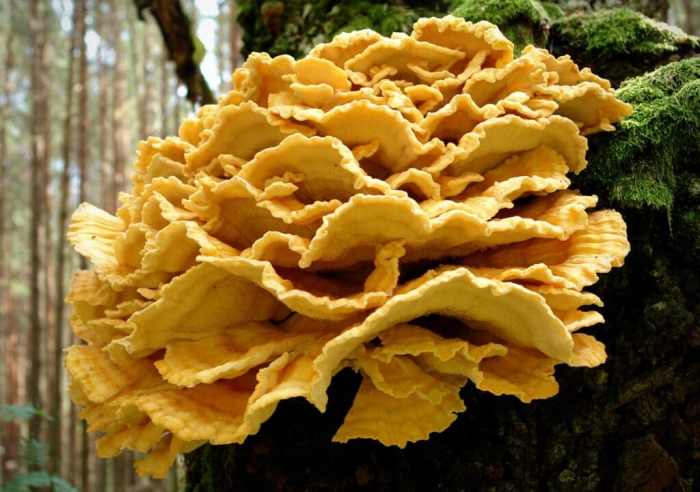
Preparing Chicken of the Woods is a straightforward process that requires minimal effort. Follow these steps to enjoy the delicious and versatile flavors of this edible fungus.
If you’re looking for a unique and delicious way to enjoy mushrooms, you should definitely try chicken of the woods. This mushroom has a meaty texture and a slightly nutty flavor, making it a great substitute for chicken in a variety of dishes.
You can find chicken of the woods recipe online or in cookbooks, but here’s a simple one to get you started.
Before you begin, ensure that you have thoroughly cleaned and identified your Chicken of the Woods to avoid consuming poisonous look-alikes.
Cleaning and Preparing, Chicken of the woods recipe
- Trim and discard any woody or tough parts.Chicken of the Woods often has a tough base that is not suitable for consumption. Remove these parts using a sharp knife.
- Slice the Chicken of the Woods into bite-sized pieces.The size of the pieces will depend on your preference and the cooking method you choose.
- Wash the Chicken of the Woods thoroughly.Rinse the pieces under cold water to remove any dirt or debris. Pat them dry with a clean towel.
Cooking
Chicken of the Woods can be cooked in various ways, including sautéing, roasting, grilling, or frying. Choose the method that best suits your taste and dietary preferences.
Sautéing
- Heat a large skillet over medium heat.
- Add a drizzle of olive oil or butter.
- Add the Chicken of the Woods pieces and cook for 5-7 minutes per side, or until they are tender and slightly browned.
- Season with salt, pepper, and any other desired herbs or spices.
Roasting
- Preheat your oven to 400°F (200°C).
- Toss the Chicken of the Woods pieces with olive oil, salt, and pepper.
- Spread the pieces on a baking sheet and roast for 15-20 minutes, or until they are tender and slightly browned.
Grilling
- Preheat your grill to medium heat.
- Brush the Chicken of the Woods pieces with olive oil.
- Grill the pieces for 5-7 minutes per side, or until they are tender and slightly charred.
Frying
- Heat a large pot or deep fryer to 375°F (190°C).
- Dip the Chicken of the Woods pieces in a batter of your choice.
- Fry the pieces for 3-5 minutes, or until they are golden brown and crispy.
Additional Culinary Inspirations

Chicken of the Woods is an incredibly versatile culinary ingredient that can be incorporated into a wide range of dishes. From soups and stews to tacos and pizza, its unique flavor and texture make it a welcome addition to any meal.
Here are some creative ideas to inspire your culinary adventures with Chicken of the Woods:
The meaty texture of Chicken of the Woods makes it an excellent substitute for chicken or other meats in a variety of recipes. Try it in stir-fries, curries, or as a topping for tacos or burritos. Its mild flavor allows it to pair well with a wide range of spices and seasonings, so don’t be afraid to experiment and create your own unique dishes.
Pairing Suggestions
Chicken of the Woods pairs well with a variety of flavors and ingredients. Its earthy flavor complements rich sauces, such as mushroom gravy or a creamy Alfredo sauce. It also pairs well with acidic flavors, such as lemon juice or vinegar, which can help to balance out its richness.
Try it in a salad with a citrus vinaigrette or add it to a stir-fry with a splash of soy sauce or rice vinegar.
Last Point
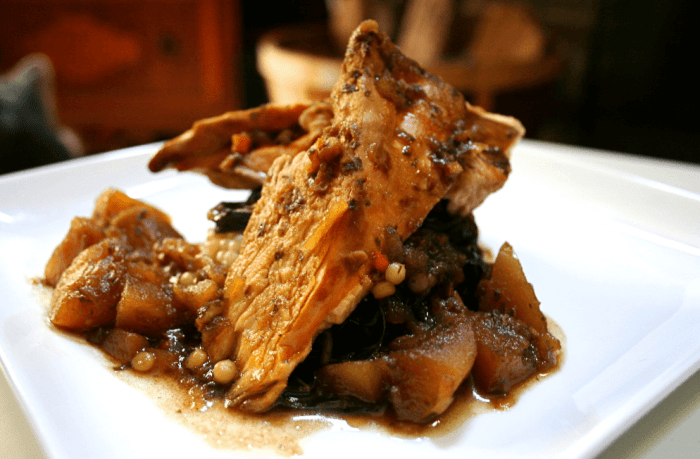
In this comprehensive guide, we’ve covered the nutritional benefits, harvesting techniques, and step-by-step recipes to empower you in your culinary journey with chicken of the woods. Embrace the flavors of the forest and elevate your meals to new heights.
Quick FAQs
What does chicken of the woods taste like?
Chicken of the woods has a mild, slightly earthy flavor that resembles chicken or seafood.
Is chicken of the woods poisonous?
No, chicken of the woods is not poisonous and is safe to consume when properly identified and cooked.
How do you clean chicken of the woods?
Gently brush off any dirt or debris and use a damp cloth to wipe away any remaining particles.